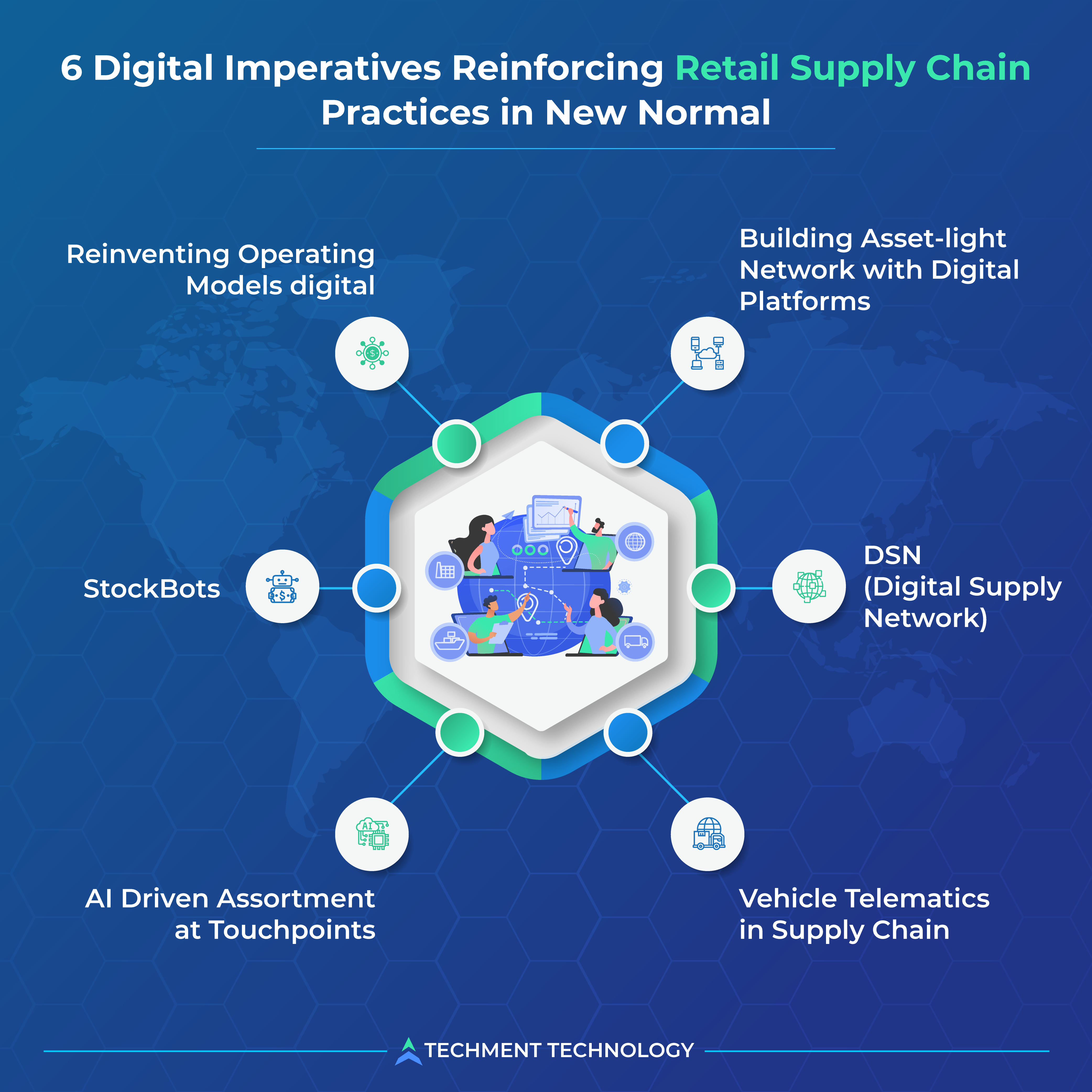The supply chain in retail was immensely affected last year due to a pandemic which along with the growing trade competitions also brought technological disruptions. More focus on logistic costs affected the resiliency and flexibility of the supply chain which made it more fragile and prone to disruption. For a better future of the supply chain, rethinking, redesigning, and leveraging new technologies become more important for making it flexible.
With the pandemic, the dependency of the retail supply chain became more dependent on e-commerce which pressurized the supply chain. Moreover, the focus shifted towards essential items and blurred the focus from non-essential items and luxury brands. Now that the survival of non-essential goods is tough, a question of their survival arises. There is not necessarily a one-size-fits-all approach but some best practices can be adopted in the new normal.
Challenges Faced by Retail Supply Chain After Pandemic
- Weak Demand: As pandemic restricted the movement of humans and goods, affected the travel industry and economy, it also brought weak consumer sentiments, job loss and shifted the importance towards essential items and demand dropped.
- Liquidity Crisis and Credit Crunch: Businesses were under pressure during a pandemic to overcome the overhead costs like rental, electricity, etc. which was more difficult for MSMEs. Some industries even have to overcome loan obligations.
- Lack of Data & Insights: Companies faced issues in collecting actionable data for prediction and informed decisions due to a drop in purchase action by customers.
- Birth of Single-Source: Pandemic forced many businesses to adopt single-source strategy as a perception of low-cost approach but at the same time also threatens the vulnerabilities of lack of supply in some time or at certain locations. This has become the guaranteed way to lose sales.
6 Digital Imperatives Reinforcing Retail Supply Chain Practices in New Normal
With pandemics hitting the supply chain, companies have got a chance to bring changes in their supply chain, adopt new technologies, and evolve the supply chain planning function. Businesses should take steps to reposition the operations with these key areas:
1. Reinventing Operating Models ()digital : Most of the businesses including retail were not prepared for the sudden shock of the pandemic, also the pace of disruption and customer expectation saw a sudden change for which supply chain operations were not convenient. It is important to develop the operation for long-term value creation and achieve financial improvement. Certain imperative to improve the operations are:
- Recreate CX Vision: Retailers must try reshaping their vision aligned with customer expectations. It will bring agility and resilience when processes and priorities are aligned with demand trends also listing the plan if a sudden disruption in consumer behavior emerges.
- Digital Operations: Develop and test the digital use cases in the processes where it is required. Technologies like automation and predictive analytics have many benefits to provide.
Predictive analysis allows forecasting the demand by analyzing the past and current trends. Also, it allows detailed inventory requirements by region and usage. Automated replenishment software is a system that engages real-time data with key metrics (i.e., daily sales, existing stocks, on order stocks, etc.) across all stores and e-commerce platforms if applicable and enables the management of the reorders. This actually uses real-world- real-time data about how much has been sold in the past.
2. Building Asset-light Network with Digital Platforms: A new practice of the supply chain ecosystem is an “asset-light network” where retailers don’t build or own assets, capabilities, resources, or tools rather they operate it with help of partners to fulfill the fast-changing needs. This becomes possible with digital platforms like digital freight brokerage platforms. These platforms avoid ambiguity by sharing data and making informed decisions.
“Today, companies of all types and sizes are using asset-light strategies to deal with massive market disruption and drive continued growth,” said Willem Appelo, former Worldwide Vice President Supply Chain, Strategy, Innovation and Deployment, Johnson & Johnson.
Frost & Sullivan estimates the digital freight brokerage market will reach $54.2 billion by 2025.”
3. Vehicle Telematics in Supply Chain: Enabling technologies like IoT, sensors, AI, robotics, etc. are being deployed in specific applications in supply chain and logistics. One way to digitize logistics is to adopt vehicle telematics which does vehicle tracking with wireless devices and GPS. It’s not only about vehicle tracking but knowing the status of on-boarding products and delayed products’ status. IoT being one of the powerful technology for communication which incorporates
- RFID:- To control and track the products
- GPS :- For vehicle tracking
- On-boarding diagnostic (OBD-II) :- To receive information on vehicle maintenance and driving conditions.

In future, the increasing volume of global trade will pressurize the logistic services and the global logistics market is extrapolated to reach a value of US$ 15,273.21 bn by 2027, the end year of the forecast period, according to TMR research.
4. DSN (Digital Supply Network): Supply chain is usually linear and requires continuous changes in designing, planning, making, and delivering. To bring desired transparency and improve the supply chain, an interconnected and open system is needed which will be the foundation of competing companies in the future. This open system is DSN (Digital Supply Network). DSNs integrate different pieces of information from different sources and locations to drive the physical act of production and distribution.
Growth in DSNs can be followed by these steps:
- Knowing about the technologies that aid DSN.
- Defining the role of DSN for wider business strategies.
- Examining the trade-offs in the supply chain and finding out methods to mitigate these trade-offs.
- Building suitable DSNs for your companies’ supply chain.
5. StockBots: While Stock Management is at the center of the retail business, it is hard to have exact control of its stream with infrequent manual inventories. StockBot is the distinct advantage here since it robotizes stock-taking. It utilizes RFID and advanced mechanics route to refresh dependable stock information, including the 3D area of products continuously. This reliable information is the key for retailers to break down stock.
6. AI Driven Assortment at Touchpoints: Assortments affect both retailers and manufacturers and is the heart of retail supply chain. Merchandising processes are dependent on in-depth data insights of customer behavior, so retailers are aware of leveraging the data. AI is leveraged in combination with advanced analytics, control parameters and algorithms to improve the assortment process. The Retail Assortment Optimization Application (RAOA) along with AI improves assortment by ingesting more and more diverse data like sales, store display space, local trends, online behavior, etc.
Manufacturers must take a tough check of existing operating models i.e., the way work gets done that are challenging legacy ways of working, and building in additional transparency and intelligence across core workforce dimensions. These are essential steps for retailers to reshape their functioning.
Resiliency is Important for Reforming Supply Chain in Future
Once the immediate risks to a supply chain are identified, leaders must then design a resilient supply chain for the longer term. This begins with establishing a supply-chain-risk function tasked with assessing risk, continually updating risk-impact estimates and remediation strategies, and overseeing risk governance. By building and reinforcing one source of truth, a digitized supply chain strengthens capabilities in anticipating risk, achieving greater visibility and coordination across the availability chain, and managing issues that arise from growing product complexity.
Focus on Visibility: Increased visibility will assist you to understand the state of your supply chain at each link, regardless of what volatility threatens your organization. Visibility is now a highly achievable goal for several organizations with digitization. With the proper technological solutions, the company can access information on every link in the chain.
With more visibility in the supply chain, companies can prevent minor issues, like order errors or delivery delays. Having the ability to access that sort of data quickly and simply is imperative to pace up the efficiency, reliability, and resiliency of the entire supply chain and organization.
 All Posts
All Posts


